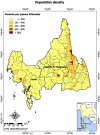Socio-Economic Resilience to Floods in Coastal Areas of Thailand
- PMID: 35742564
- PMCID: PMC9223729
- DOI: 10.3390/ijerph19127316
Socio-Economic Resilience to Floods in Coastal Areas of Thailand
Abstract
Krabi and Nakhon Si Thammarat are two coastal provinces in Thailand facing substantial threats from climate change induced hydrometeorological hazards, including enhanced coastal erosion and flooding. Human populations and livelihoods in these coastal provinces are at greater risk than those in inland provinces. However, little is known about the communities' resilience and coping capacities regarding hydrometeorological hazards of varying magnitudes. The study conducted a quantitative socio-economic assessment of how people in Krabi and Nakhon Si Thammarat provinces manage and respond to hydrometeorological hazards, examining their resilience and coping capacities. This was a cross-sectional study based on secondary data collection on the social and economic dimensions of resilience, and a review of literature on coping mechanisms to hydrometeorological hazards within the study area. Measuring and mapping socio-economic resilience was based on the available data gathered from the social and economic dimensions, with existing or standard indicators on exposure and vulnerability applied uniformly across subdistricts. A combination of social and economic dimensions produced novel socio-economic resilience index scores by subdistrict, which were mapped accordingly for the two coastal provinces. The study also derived a coping capacity index scores by combining availability of skills or soft capacity and availability of structural resources or hard coping capacity. Socio-economic resilience index scores varied greatly amongst subdistricts. Combining the soft and hard coping capacities, the average score across districts in both provinces was 3 out of a possible 4, meaning that most of the districts were largely resilient. However, variations also existed by subdistrict. Few subdistricts in both Krabi and Nakhon Si Thammarat provinces had low coping capacity index scores between 1 and 2 out of 4. District averages of socio-economic resilience scores mask the variations at subdistrict level. More studies with rigorous methodologies at village or neighborhood level is needed to obtain a nuanced understanding of community resilience to hydrometeorological hazards.
Keywords: coping capacity; floods; resilience; socio-economic; vulnerability.
Conflict of interest statement
The authors declare no conflict of interest.
Figures









Similar articles
-
Coastal Erosion and Flood Coping Mechanisms in Southern Thailand: A Qualitative Study.Int J Environ Res Public Health. 2022 Sep 28;19(19):12326. doi: 10.3390/ijerph191912326. Int J Environ Res Public Health. 2022. PMID: 36231625 Free PMC article.
-
Framework for mapping the drivers of coastal vulnerability and spatial decision making for climate-change adaptation: A case study from Maharashtra, India.Ambio. 2019 Feb;48(2):192-212. doi: 10.1007/s13280-018-1061-8. Epub 2018 May 31. Ambio. 2019. PMID: 29855893 Free PMC article.
-
On mapping urban community resilience: Land use vulnerability, coping and adaptive strategies in Ghana.J Environ Manage. 2024 Nov;370:122426. doi: 10.1016/j.jenvman.2024.122426. Epub 2024 Sep 8. J Environ Manage. 2024. PMID: 39244927
-
Geospatial indicators of exposure, sensitivity, and adaptive capacity to assess neighbourhood variation in vulnerability to climate change-related health hazards.Environ Health. 2021 Mar 22;20(1):31. doi: 10.1186/s12940-021-00708-z. Environ Health. 2021. PMID: 33752667 Free PMC article.
-
Community resilience to floods in the coastal zone for disaster risk reduction.Jamba. 2018 Apr 23;10(1):356. doi: 10.4102/jamba.v10i1.356. eCollection 2018. Jamba. 2018. PMID: 29955249 Free PMC article. Review.
Cited by
-
Coastal Erosion and Flood Coping Mechanisms in Southern Thailand: A Qualitative Study.Int J Environ Res Public Health. 2022 Sep 28;19(19):12326. doi: 10.3390/ijerph191912326. Int J Environ Res Public Health. 2022. PMID: 36231625 Free PMC article.
References
-
- Thanvisitthpon N., Shrestha S., Pal I., Ninsawat S., Chaowiwat W. Assessment of flood adaptive capacity of urban areas in Thailand. Environ. Impact Assess. Rev. 2020;81:106363. doi: 10.1016/j.eiar.2019.106363. - DOI
-
- WBG (World Bank Group) ADB (Asian Development Bank) Climate Risk Country Profile: Thailand. 2021. [(accessed on 29 May 2022)]. Available online: https://climateknowledgeportal.worldbank.org/sites/default/files/2021-08....
-
- UNDRR (United Nations Office for Disaster Risk Reduction) Terminology: Coping Capacity. [(accessed on 29 May 2022)]. Available online: https://www.undrr.org/terminology/capacity.
-
- UNDP (United Nations Development Programme) Terminal Evaluation Report: Strengthening the Capacity of Vulnerable Coastal Communities to Address the Risk of Climate Change and Extreme Weather Events. [(accessed on 29 May 2022)]. Available online: https://erc.undp.org/evaluation/evaluations/detail/5997.
-
- Willroth P., Massmann F., Wehrhahn R., Diez J.R. Socio-economic vulnerability of coastal communities in southern Thailand: The development of adaptation strategies. Nat. Hazard Earth Sys. 2012;12:2647–2658. doi: 10.5194/nhess-12-2647-2012. - DOI
Publication types
MeSH terms
LinkOut - more resources
Full Text Sources
Medical

